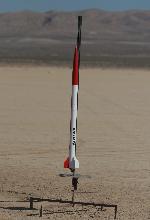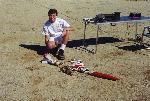Small Arcas

| Diameter: | 2.64" | Type: | Scale |
| Length: | 56.5" | Status: | Active - 13 flights |
| Motor Mount: | 54mm | Build Dates: | 2004-03-01 to 2007-01-01 |
Small Arcas is the third 2.6" diameter revision of everyone's favorite sounding rocket. The first (our AT kit) kept breaking fins, and was finally retired after we lost the broken piece. The second (made from LOC tubing) shredded in spectacular fashion on an I435T while trying to gather data for my 7th grade science project. Traumatized by these past experiences, this third version used glassed phenolic tubing with G10 fins, surface mounted and covered tip-to-tip in carbon-Kevlar. It's also built as a sustainer, with room for a stage coupler, so one day it might fly as a two stager, too.
Flights
Since the first flight seemed a bit underpowered, I figured a step up in motor size was a good idea. We'd had a J420R around for a while, and it seemed like the perfect motor to kick the small Arcas and really get it moving. The boost was fast and straight, with the drogue appearing at apogee, and the main at 800'. The (excessively large?) main deployment charge broke the plastic loop on the nose cone, but no matter -- a little Kevlar and some paint and we're back in business.
For the first flight of the Small Arcas, I chose one of my dad's favorite motors - the I211W. I figured this would give a decent ride to ~3500 feet so we could see the whole flight and deployment sequence. The boost was gentle, with a bit of porpoising (needs a bigger motor....) and both deployment events happened right on time. A good first flight.
others: dad preflight | recovery
For my project, I wanted to compare altitudes reached with a light rocket and a heavy rocket, aiming to prove that such a thing as "optimal mass" existed. Unfortunately, I didn't have much knowledge of carbon fiber at the time, and the only rocket that was around that was light enough to prove this was the all-paper 2.6" Arcas. So we put an I435T in it with an ALTS2 for data recording, and hoped for the best. It was the most awesome shred I've ever had; the rocket looked like a big white flower blooming in the sky. And so ended Arcas v2!

others: avionics prep
For our first flight of the new lightweight-scratch built-paper-38mm-motored Arcas, I chose the H123W. I was really excited, as this was the first time I'd put rail buttons on a rocket, and thus the first time I got to go off Pad 39A! The flight was gorgeous and straight, with the orange Aerotech chute deploying at apogee.
Though it was still windy on Sunday morning, seeing Hulan Matthies fly his Mini Magg on a K550 inspired me to put up a rocket, too. We loaded the Arcas with a G64 for an awesome high flight; even with the wind, it still managed to go nearly straight up on a big, bright flame. The chute appeared at apogee, but it broke a fin again on landing, and with the wind dragging the airframe along the lakebed, we lost the fin piece to the desert. RIP Small Arcas v1.
This G64 was leftover from the month before; we had loaded it up but had to leave the launch early, so after re-tightening the closures, it was ready to go for this month. The rocket flew high and straight, but broke a fin on landing, as was becoming de rigeur with this vehicle at Lucerne.
Since there was no wind, this flight was straight up and very high.
We had assembled this G33 to fly at the January launch, but I called off the flight "due to high, gusty winds," according to the flight log. The whole thing got disassembled and stored in a Ziploc bag for the interim. I quickly reassembled the motor on-site and we got the Arcas on the pad early. At ignition, the motor chuffed several times before the rocket lifted slowly off the pad. Ejection was extremely late, resulting in a significant zipper and cracked fin. A little epoxy and microballoons and she was in flying shape again.
For the fourth flight of the Arcas, we had selected the biggest motor that would fit - an Aerotech G80T - to really push its limits. The flight was high, fast, and straight, with an apogee ejection, but landing brought a surprise: the single use motor had managed to eject by the Aerotech motor hook. Note for next time - add extra tape to secure the motor, especially when flying with our reload case!
Daybreak saw us loading another G64 for what was now my favorite rocket of our fleet. The flight on the fifth reload for our 29/40-120 case was again nominal, and recovered much closer than it did last time!
The Arcas did well on the G33, so for its next flight, as the sun was setting, we loaded it up with a G64. The rocket had a beautiful flight on a big, bright flame, but landed really far out on the lakebed. No big deal - there's nothing like a nice walk in the cool desert at sunset!
I had always loved the black smoke plume of the BlackJack propellant, since it was something completely different and unusual from that available in black powder motors. As such, our third reload in the 29/40-120 case was the BlackJack G motor. The Arcas made a graceful, slow flight on the G33, with on-time ejection at apogee handled by the 5 second motor delay.
After watching the "big dogs" at DART fly G motors successfully all morning, we decided to go for the gusto and put a mighty F50 in our Aerotech Arcas. Veteran flier Ray (?) helped us load the rocket on the pad and adjust the angle "just so" to prevent the recovery portion of the flight from occurring in Mission Bay, as is always the challenge at DART launches. As we cleared the pad area and armed the relay box, I was so nervous that I couldn't stand still. My dad called out the count and hit the launch button, and the Arcas rode fast and high into the air on a smokeless Blue Thunder plume. The chute appeared at apogee, but the upper level winds were stronger than anticipated, carrying the rocket smack into the water. D'OH! My dad, ever dedicated, stripped off his shirt and went swimming to recover the bird, and after drying the insides with a hair dryer, she was good as new again. Success on our first composite motor flight!



